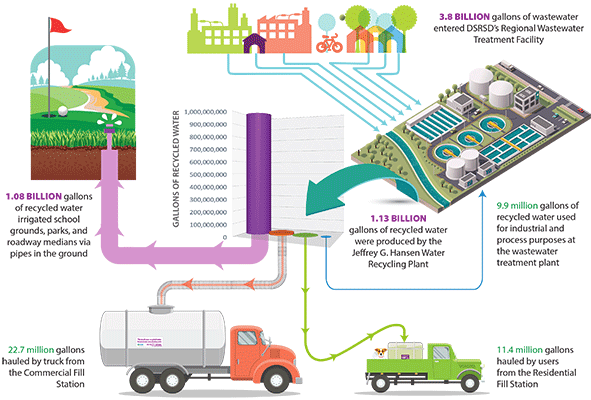Situation: The State Water Project (SWP) normally provides almost all of our drinking water. Zone 7 Water Agency, the valley's water wholesaler, plans for dry years by banking surplus water during wet years. Their “water bank” includes Lake Del Valle, the local groundwater basin, and groundwater storage facilities in Kern County (southern California). Zone 7 taps these reserves when needed, but depending on them exclusively is like living on your savings without replenishing it; eventually you exhaust your supply.
Solution: To reduce the amount of potable water used for non-potable purposes, DSRSD produces recycled water for irrigation and construction. In 2016, recycled water accounted for 24 percent of total water consumption by DSRSD customers, up from 10 percent in 2006.
Recycled water is reducing the region’s dependence on imported water from the environmentally stressed Sacramento-San Joaquin Delta. Recycling turns treated wastewater into a useful resource instead of a waste product discharged into the San Francisco Bay, and it keeps this valuable local resource in the local community.
Purple Pipes Deliver Most of Our Recycled Water
As shown in the chart below, nearly all the recycled water produced at the regional facility—96 percent—is delivered through dedicated pipelines to parks, school grounds, golf courses, and other large landscapes. Tanker trucks hauling water to construction sites, the residential pickup program, and industrial uses at the treatment plant accounted for the rest of the 1.13 billion gallons produced in 2016. Click the chart to open a larger view (PDF).
Recycled Water Uses in 2016
|

|
|
Water Recycling Takes Years of Investment
Recycled water is available in the Tri-Valley today because planning and infrastructure investment began in the early 1990s. DSRSD partnered with East Bay Municipal Utility District to build the Jeffrey G. Hansen Water Recycling Plant (named after a former DSRSD director who led the effort to develop recycled water locally), as well as a distribution network of pipelines, pumping stations, and storage reservoirs.
The backbone system cost $82 million and was funded by federal and state grants (24 percent of the project’s cost), low-interest loans, water rates, and fees that developers pay to reserve capacity in the system. Today, the City of Pleasanton has joined DSRSD and EBMUD in making additional investments to expand the water recycling capacity to serve a growing number of irrigation customers.






